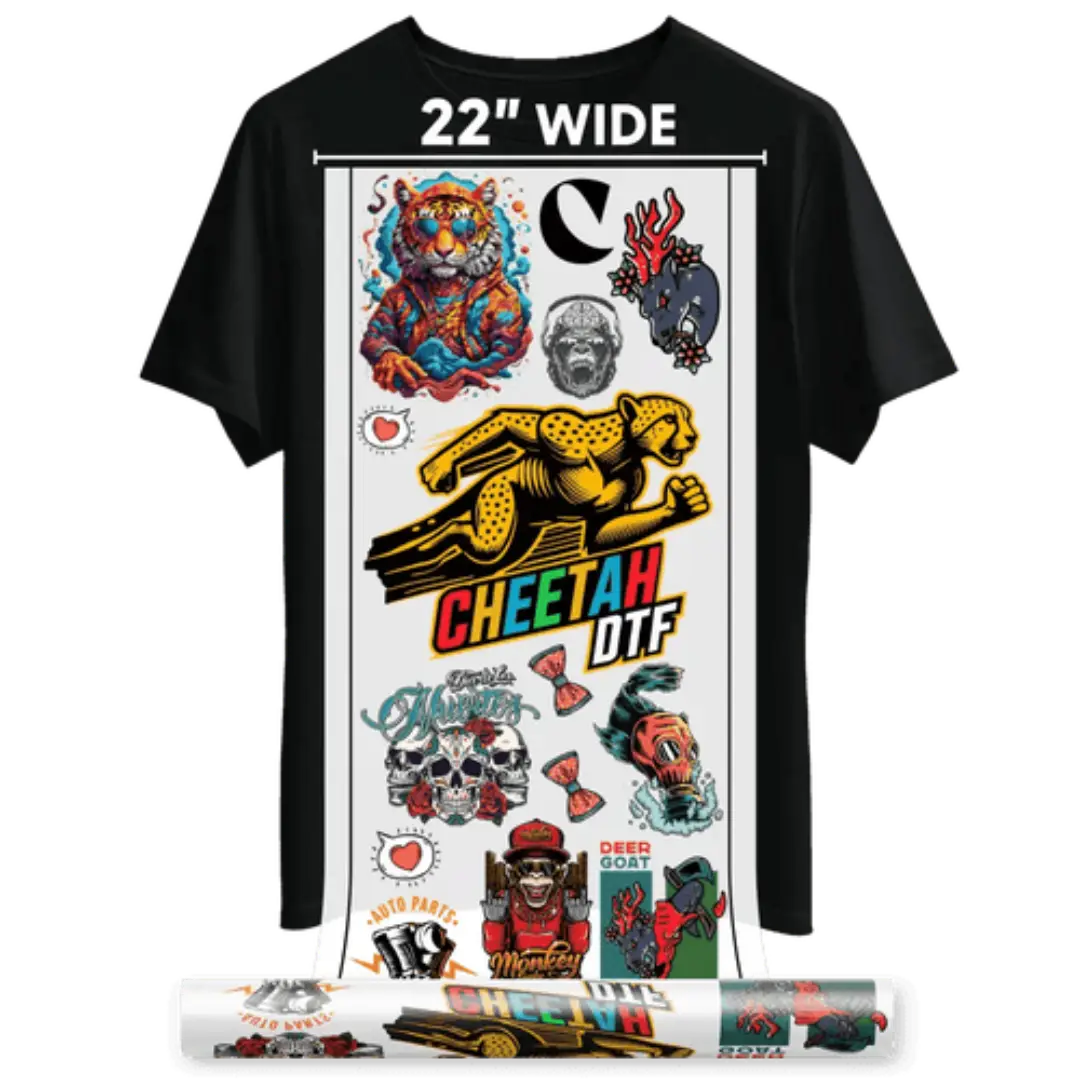DTF Printing FAQs: 15 Most Common Questions Answered
Thanks to its flexibility, vivid hues, and ability to be applied across materials, Direct-to-Film (DTF) printing has taken the custom apparel industry by storm. If you are looking to get started in this business, there are a couple of basic things that you must know. You may have a few questions if you're contemplating incorporating DTF into your company or want to know how it works. Here we address the fifteen most common DTF printing FAQS people have about DTF printing to help you determine if it suits your needs, whether for business or artistic endeavors. So without further ado, let's dive in!
15 DTF Printing FAQs For Entrepreneurs
1. What is DTF printing?
Direct-to-film printing is DTF. In the DTF printing process, the design is printed with water-based inks onto a particular PET film rather than directly onto fabric. While the ink is still wet, an adhesive powder is applied; next, the print is cured and ultimately heat-transferred to the clothing. Offering versatility and color brightness without the complicated setups often required by conventional techniques, such as screen printing or DTG, this method works on a wide range of materials, including cotton, polyester, blends, nylon, and more.
2. Which gear do I need for DTF printing to get started?
Beginning DTF printing requires several basic supplies: a dedicated DTF print or a converted inkjet print, water-based DTF inks including white ink, PET transfer film (available in cold peel or hot peel forms), hot melt adhesive powder, and a heat press for transferring the design. A heat press or a little curing oven can be utilized to cure the powder. To increase efficiency, larger print businesses often incorporate automated powder shakers and dryers; however, these are discretionary when you are just starting. Regular DTF printing maintenance keeps everything working smoothly.
3. What is DTF vs DTG?
DTG (direct-to-garment) technology simply sprays the design directly onto the shirt, much like a high-end inkjet print for your clothes. DTF (direct-to-film) is similar to making a decal: you print your art onto special film, dust it with adhesive powder, and then iron the design onto any fabric you choose. Cotton, polyester, blends, and even blended synthetics are suitable for this process. DTG feels a bit softer when printing on a high-cotton shirt, but DTF is significantly more flexible and faster for small batches or any material other than plain cotton. It all comes down to the DTF printing process that makes it so versatile.
4. Is DTF printing eco-friendly?
DTF isn’t automatically green, but you can take several steps to improve it. Use non-toxic or water-based inks, or opt for recycled or recyclable options whenever possible. Additionally, innovative layouts (gang sheets) cut down on waste. People are even swapping out boring old plastic mailers for stuff that breaks down. And if you work with suppliers who care about ethical manufacturing, you’re ticking the right boxes. Plus, doing this usually won’t increase your DTF printing cost by much, especially compared to what you save on wasted film and materials.
5. How durable are DTF prints?
A DTF shirt can withstand fifty or more washing cycles before showing any significant fading or cracking. That hot-melt adhesive gets in there and makes the print stick. A decent PET film, solid inks, and using the proper heat press temperature all contribute to the print's quality. Take care of those, and your prints will hold up for years to come. That’s why people value DTF printing durability so highly when comparing printing methods.
6. Which kinds of apparel and goods are printable?
Among the primary benefits of DTF printing is its tolerance for a wide range of fabrics, including cotton, polyester, blends, nylon, canvas, and other materials. Perfect for t-shirts, hoodies, tote bags, caps, athletic apparel, aprons, and even some footwear, it works just as well on dark or light materials without pretreating. This flexibility means you can do DTF printing on cotton and DTF printing on polyester equally well, and offer a bigger catalog of products without switching technologies.
7. How do cold peel and hot peel film function?
For cold peel, you let the film cool completely before peeling it off, often resulting in a smooth, matte finish after heat pressing the design onto the garment. Hot peel film allows you to peel right after pressing while it’s still warm, which speeds up production and sometimes yields a glossier finish. Your choice depends on your design look and how quickly you need your DTF printing turnaround time to meet orders.
8. Why should I utilize a gang sheet?
Printed all at once on a larger PET film sheet, known as a gang sheet, are numerous designs, logos, or artistic creations. Perfect for small businesses or custom orders, this speeds production, reduces waste, and cuts the cost per transfer. Many print software tools help you lay out gang sheets, ensuring nothing is wasted. An innovative layout can boost margins and help your eco goals, particularly if your shop handles a high volume of small custom orders.
9. Do I need particular software to start the DTF printing business?
Yes, the professional DTF printing process relies on RIP (Raster Image Processor) software to manage colors and white ink layers. Programs like AcroRip, CadLink, or DigiRIP ensure that ink distribution is balanced, colors appear correctly, and prints don’t waste ink. Investing in software is one of the most intelligent choices a business can make to maintain quality and reduce material waste, mainly when producing complex, colorful, or frequent custom prints.
10. How to apply the adhesive powder properly?
Sprinkle hot-melt adhesive powder onto the wet design on the PET film immediately after printing. Shake lightly so excess powder falls off, then cure the powder (with an oven or by hovering your heat press). The powder melts into the ink, creating a sticky layer that bonds firmly when heat-pressed onto fabric. Done right, this keeps designs smooth and lasting through many washes.
11. What causes DTF prints to break or peel?
Cracking or peeling typically occurs due to excessive or insufficient heat, pressure, improper curing, or the use of inferior materials. If the adhesive powder isn’t melted fully, it won’t bond well; excessive heat can make the designs brittle. Old heat presses can also have cold spots that mess up curing. Following the right temperature guides and DTF printing maintenance tips can help you prevent peeling problems.
12. Can I use DTF transfers on dark fabrics?
Absolutely. Printing on dark fabrics is where DTF shines. The white ink underbase makes colors pop, so designs don’t look dull like they sometimes do with other methods. No special pretreatment is required, and it works well on cotton, blends, polyester, and other synthetics, unlike sublimation, which is only compatible with poly.
13. How does DTF printing compare to screen printing?
Screen printing is unbeatable for large, same-design orders and offers a low cost per print after setup. However, DTF is faster and more cost-effective for small runs, multi-color prints, or photorealistic images: no screens to burn, less mess, and no big upfront setup. If your work changes daily, DTF fits better; for a thousand identical tees, screen printing wins.
14. What are the ongoing costs of DTF printing?
The regular costs of the DTF printing process include PET film, white and colored inks, adhesive powder, as well as cleaning supplies and software. Smart shops lower costs by using gang sheets, purchasing film in rolls, and keeping a careful track of their usage so that nothing is wasted. You’ll also factor in power, occasional part replacements, and software updates.
15. Is DTF printing right for my business?
For custom shirts, small orders, and mixed materials, DTF is usually great. It’s quick, flexible, and you don’t need massive startup money. Additionally, using water-based inks and recyclable PET film helps with eco-branding. Consider what your customers want and your product offerings. No single method is perfect, but DTF covers a lot.
Final Thoughts: Getting Started with Cheetah DTF
With Cheetah DTF, you can start your DTF hustle without a hassle. With quality supplies, trained staff, and lightning-fast shipping, our services are tailored to help you start a lucrative business. DTF is like a Swiss Army knife for modern print shops: speed, bright colors, and it works on almost any fabric. With us, you can learn to use gang sheets, apply powder right, and store film carefully, to print faster, waste less, and impress your customers.
Want to see quality first? Try our DTF sample pack before committing. Have more DTF printing FAQs? Contact us, and our customer support team will help answer all your questions to help you get started quickly.


